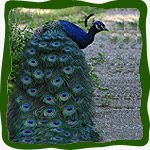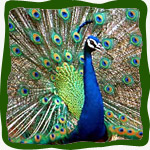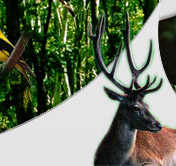|
About
|
|
The male Indian Peafowl, commonly known as the peacock, is one of the most recognizable birds in the world. These large, brightly colored birds have a distinctive
 crest and an unmistakable ornamental train. The train (1.4-1.6 meters in length) accounts for more than 60% of their total body length (2.3 meters). Combined with a large wingspan (1.4-1.6 meters), this train makes the male peafowl one of the largest flying birds in the world. The train is formed by 100-150 highly specialized uppertail-coverts. Each of these feathers sports an ornamental ocellus, or eye-spot, and has long disintegrated barbs, giving the feathers a loose, fluffy appearance. When displaying to a female, the peacock erects this train into a spectacular fan, displaying the ocelli to their best advantage. crest and an unmistakable ornamental train. The train (1.4-1.6 meters in length) accounts for more than 60% of their total body length (2.3 meters). Combined with a large wingspan (1.4-1.6 meters), this train makes the male peafowl one of the largest flying birds in the world. The train is formed by 100-150 highly specialized uppertail-coverts. Each of these feathers sports an ornamental ocellus, or eye-spot, and has long disintegrated barbs, giving the feathers a loose, fluffy appearance. When displaying to a female, the peacock erects this train into a spectacular fan, displaying the ocelli to their best advantage. |
|
The more subtly colored female Peafowl is mostly brown above with a white belly. Her ornamentation is limited to a prominent crest and green neck feathers. Though females (2.75-4.0 kg) weigh nearly as much as the males (4.0-6.0 kg), they rarely exceed 1.0 meter in total body length. |
|
National Insignia |
|
The Indian
peacock, Pavo cristatus (Linnaeus), the national bird of India, is a colourful, swan-sized bird, with a fan-shaped crest of feathers, a white patch under the eye and a long, slender neck. |
|
The peacock is widely found in the Indian sub-continent from the south and east of the Indus river, Jammu and Kashmir, east Assam, south Mizoram and the whole of the Indian peninsula. The peacock enjoys immense protection. It is fully protected under the Indian Wildlife Protection) Act, 1972. |
|
Distribution and Habitat |
|
The Indian Peafowl occurs from eastern Pakistan through India, south from the Himalayas to Sri Lanka. Though once common in Bangladesh, it may now be extinct in that country. Its highly ornamental appearance motivated early seafarers to transplant the peafowl to their homelands in other parts of the western world. Phoenician traders in the time of King Solomon (1000 B.C.) introduced the birds to present-day Syria and the Egyptian Pharaohs. |
|
In its native India, the peafowl is a creature of the open forests and riparian undergrowth. In southern India, it also prefers stream-side forests but may also be found in orchards and other cultivated areas. |
|
Diet |
|
Indian Peafowl do most of their foraging in the early morning and shortly before sunset. They retreat to the shade and security of the forest for the hottest portion of the day. Foods include grains, insects, small reptiles, small mammals, berries, drupes, wild figs, and some cultivated crops. |
|
Conservation and History of Relationship with Man |
|
 The great beauty and popularity of the Indian Peafowl has guaranteed its protection throughout most of its native and introduced ranges. It is the national bird of India. The peafowl is prominent in the mythology and folklore of the Indian people. The Hindus consider the bird to be sacred because the god Kartikeya (son of the Lord Shiva and Parvati and brother to the god Ganesh) rides on its back. Legends hold that the peafowl can charm snakes and addle their eggs. The great beauty and popularity of the Indian Peafowl has guaranteed its protection throughout most of its native and introduced ranges. It is the national bird of India. The peafowl is prominent in the mythology and folklore of the Indian people. The Hindus consider the bird to be sacred because the god Kartikeya (son of the Lord Shiva and Parvati and brother to the god Ganesh) rides on its back. Legends hold that the peafowl can charm snakes and addle their eggs. |
|
Greek mythology describes how the peacock acquired the many eyes in his
ornamental train. The goddess Hera had a beautiful priestess named Io. Io was greatly admired by Zeus. To protect her from Hera’s jealousy Zeus transformed Io into a heifer. Hera tricked Zeus into giving the heifer to her as a gift and set her faithful servant Argus to watch over her. Argus had numerous eyes all over his body, making him a natural choice for the assignment. Zeus sent the god Hermes to free Io from Hera’s watchman. Hermes charmed Argus to sleep until all of his eyes were closed and then killed him. To honor her faithful watchman, Hera took Argus’ eyes and placed them on the tail of the peacock.
|
|
This long and close association with humans has proven the peafowl’s adaptability to human-altered landscapes. This species does not appear to need any additional legal protection or conservation attention.
|
|
|
| TOP |
| |









 crest and an unmistakable ornamental train. The train (1.4-1.6 meters in length) accounts for more than 60% of their total body length (2.3 meters). Combined with a large wingspan (1.4-1.6 meters), this train makes the male peafowl one of the largest flying birds in the world. The train is formed by 100-150 highly specialized uppertail-coverts. Each of these feathers sports an ornamental ocellus, or eye-spot, and has long disintegrated barbs, giving the feathers a loose, fluffy appearance. When displaying to a female, the peacock erects this train into a spectacular fan, displaying the ocelli to their best advantage.
crest and an unmistakable ornamental train. The train (1.4-1.6 meters in length) accounts for more than 60% of their total body length (2.3 meters). Combined with a large wingspan (1.4-1.6 meters), this train makes the male peafowl one of the largest flying birds in the world. The train is formed by 100-150 highly specialized uppertail-coverts. Each of these feathers sports an ornamental ocellus, or eye-spot, and has long disintegrated barbs, giving the feathers a loose, fluffy appearance. When displaying to a female, the peacock erects this train into a spectacular fan, displaying the ocelli to their best advantage.  The great beauty and popularity of the Indian Peafowl has guaranteed its protection throughout most of its native and introduced ranges. It is the national bird of India. The peafowl is prominent in the mythology and folklore of the Indian people. The Hindus consider the bird to be sacred because the god Kartikeya (son of the Lord Shiva and Parvati and brother to the god Ganesh) rides on its back. Legends hold that the peafowl can charm snakes and addle their eggs.
The great beauty and popularity of the Indian Peafowl has guaranteed its protection throughout most of its native and introduced ranges. It is the national bird of India. The peafowl is prominent in the mythology and folklore of the Indian people. The Hindus consider the bird to be sacred because the god Kartikeya (son of the Lord Shiva and Parvati and brother to the god Ganesh) rides on its back. Legends hold that the peafowl can charm snakes and addle their eggs.